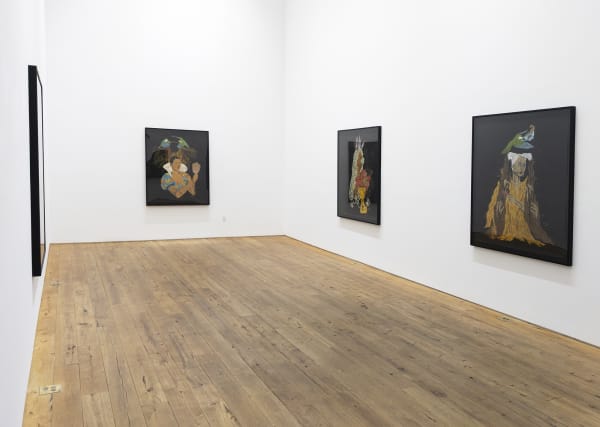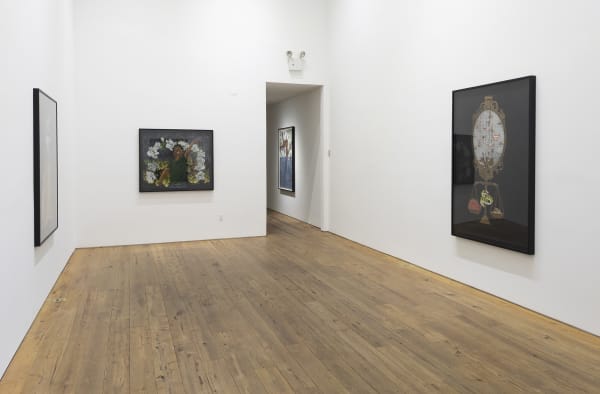Katrina Andry: Into the Water and Out of the Fire
The gallery is pleased to present Katrina Andry: Into the Water and Out of the Fire, an exhibition of works spanning from 2017 to the present. This will be Andry’s first one-person exhibition with the gallery.
The exhibition draws from three bodies of work: Afro-what-if-ism. Reimagining one night in 1811 (2022); Colonial Colorism Influences in the Black Community – Past and Present (2020); and The Promise of the Rainbow Never Came (2018). Each body of work chronicles distinct moments in history from a personal, historical, and present-day perspective. The series are jointly informed by one significant event.
The largest slave revolt in the United States happened at the Andry Plantation in LaPlace, Louisiana, on January 8, 1811. Katrina Andry, with direct lineage to the enslaved people from the plantation, wanted to bear witness to her ancestors and descendants, and pay homage to their achievements. Using family members – her twin sons, her parents, and her sisters – as protagonists in this imagined celebration, she stages this successful revolt. She juxtaposes her family members with imagery of culprits who are in a state of distress, ire, and grief over the loss of their “heritage.” In this way, the work acknowledges victims and captors. One of the most compelling works from the 1811 series is Black Imaginings of the 1811 Past and Future Possibilities (2022). In the foreground is a portrait of an exuberant Black child lifting his arm to the sky with a ground of gorgeous flowers, with everything to look forward to in life, and behind him are the ashes of a past and a re-imagined future.
The Promise of the Rainbow Never Came (2018) is in reverence to individuals that were lost during the Middle Passage, so named for the middle leg of a three-part voyage of the international slave trade, equally known as the Atlantic slave trade. Andry looks at the passage from all angles. Her imagery depicts morphing figures surrounded by transgenic sea creatures with stormy sky views of cumulus clouds and large raindrops. The fallen figures join the raindrops as they journey toward the abyss of the ocean. In these images, Andry hones her acute color sensibility by translating unfathomable sorrows into hues that deeply reflect emotions. The number of lives lost during those voyages is estimated between 200,000 to 2 million, attributed to dysentery – also referred to as “fixed melancholy” – and from drowning. However, in Andry’s storytelling, the depiction of water is also representative of hope and rebirth.
Colonial Colorism Influences in the Black Community – Past and Present (2020) bridges the other two series by considering contemporary occurrences and race relations. In particular, the work explores narratives on our collective consciousness: ethnicity, social hierarchy, black experiences, quality of life, and the collective perception of society as a whole toward race relations and social standards. Andry infuses these solemn discussions with visual humor and wordplay in the titles.
In her creative process Andry uses woodcut, the oldest form of printmaking. She was inspired to use the technique after learning that it was historically used in Europe, the United States, and Mexico as a quick mode of communication. While in Europe in was a simple mean of communication, in Mexico it was used to send political messages during the Mexican Revolution. It created a singular language through art, since multiple languages were spoken at the time. In the US it was used to inscribe messages and physical attributes of runaway slaves; words like “sullen”, “prone to violence”, “walks slowly”, “mischievous”, and “meek” were often used alongside a portrait, in the hope that these individuals would be captured and returned. Decisively, Andry embraced woodcut as her visual expression.
Andry pushes the boundaries of woodcut, a relief process that uses knives and other tools to carve a design into the surface of a wooden block, by incorporating monotypes into her practice. Through the usage of bubble wrap, or other materials that can safely go through the press while retaining texture and dimensionality, she creates what is known as a variable edition or monotype. Pushing the technique further still, she also uses color reduction. This process uses one wooden block for all the colors by layering the inks from light to dark, one color at a time. Between each color, the printing surface of the wooden block is cut, reducing the image. This allows for the preservation of the previous colors, while also creating a new color layer. The woodblock is destroyed in the process. The technique, dramatically known as “killing the block” or “suicide block printing”, renders reprints virtually impossible. Adding iridescent mylar and paper cut-outs completes her process.
Born in 1981, Katrina Andry is a native of New Orleans, LA, where she continues to live and work. Andry received an MFA in printmaking in 2010 and is widely considered to have reached mastery in woodcutting printmaking. In the September 2012 issue Art in Print magazine listed Andry as one of the top 50 printmakers. Andry’s work has been exhibited in Prospect 5 New Orleans Triennial, and she has notably shown at the Hammonds House Museum, Atlanta, GA; the Katonah Museum, Katonah, NY; the Ogden Museum of Southern Art, New Orleans, LS; the Wingate Art Museum at Hendrix College, Conway, AR; Louisiana State University Museum of Art, Baton Rouge, LA; The Halsey Institute, Charleston, SC; Pensacola Museum of Art, Pensacola, FL; among others. Andry is currently a Teaching Fellow in the MFA graduate seminar at Tulane University in New Orleans, LA.





